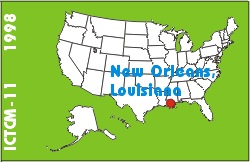
Electronic Proceedings of the Eleventh Annual International Conference on Technology in Collegiate MathematicsNew Orleans, Louisiana, November 19-22, 1998Paper C046The Use of Mathematical Modeling In an Interdisciplinary Setting |
Ronald J. HarshbargerUniversity of South Carolina Beaufort 1 College Center Hilton Head, SC 29928 USA Phone: (843) 785-3995 ronharsh@hargray.com list of all papers by this author | Jane UpshawUniversity of South Carolina Beaufort 1 College Center Hilton Head, SC 29928 USA Phone: (843) 785-3995 upshaw@hargray.com |
| Click to access this paper: |
ABSTRACT
The hotel and restaurant sector of today's global economy are among the fastest growing in the world. South Carolina is the third leading vacation destination in the United States and tourism is one of South Carolina's growing industries. Tourism contributes over $1 billion dollars to Hilton Head Island economy each year. The University of South Carolina offers a major in Hotel, Restaurant, and Tourism Administration (HRTA), which has been offered at the Hilton Head Campus for the last two years. The program has grown to over 40 majors in that short period of time, with students attending from 24 different countries. This Fall, many students in the HRTA major were taking both the HRTA Tourism course and a business calculus course. In an effort to interest these students in the power of calculus as a mathematical discipline linked to their field of study, an interdisciplinary research project was designed. The goals were to have students identify real-world data collected in an organization or business, to model the data using a continuous function, and to answer questions that would be useful in making business decisions. The project assigned was to investigate the relationship between hotel room pricing and occupancy during the off-peak season (November through February). The problem was chosen because of the inherent questions for hotel managers in a resort location such as Hilton Head Island. Because the majority of the HRTA students work in hotels during internship programs, it was an interesting problem for these students to investigate.Initially, students in the HRTA course were asked to discuss how resort hotels on Hilton Head Island could increase their occupancy rate, revenue, and profit during the off-season. Students made several suggestions about how to increase occupancy, including offering special conference packages. After these guesses were recorded, students were instructed to gather data regarding room prices and occupancy from the resort hotels on Hilton Head Island. This data was to form the basis for the solution of the problem.
Students in the Tourism class were asked to make estimates, without developing formulas, of what room price would maximize the occupancy rate, daily revenue, and profit..
The students in the calculus class were asked to: (1) Find equations that could be used to model the occupancy rate, the daily revenue, and the profit. (2) Use calculus to find the price that would maximize the occupancy rate, the daily revenue, and the profit. They found that the room price that would maximize the occupancy rate was quite different from the room price that would maximize revenue and profit.
The conclusions of the calculus class were given to the HRTA class for further discussion of how to improve occupancy and profit, and about the limitations of the mathematical solution. The student response to this collaborative learning strategy has changed the attitudes of many students in the Tourism and the business calculus classes. While they understand the limits of using continuous functions to model data, and that the models may not always fit the data well, they also see that just observing data patterns may not give all the information they need to solve management problems.
Keyword(s): calculus, modeling, applications
